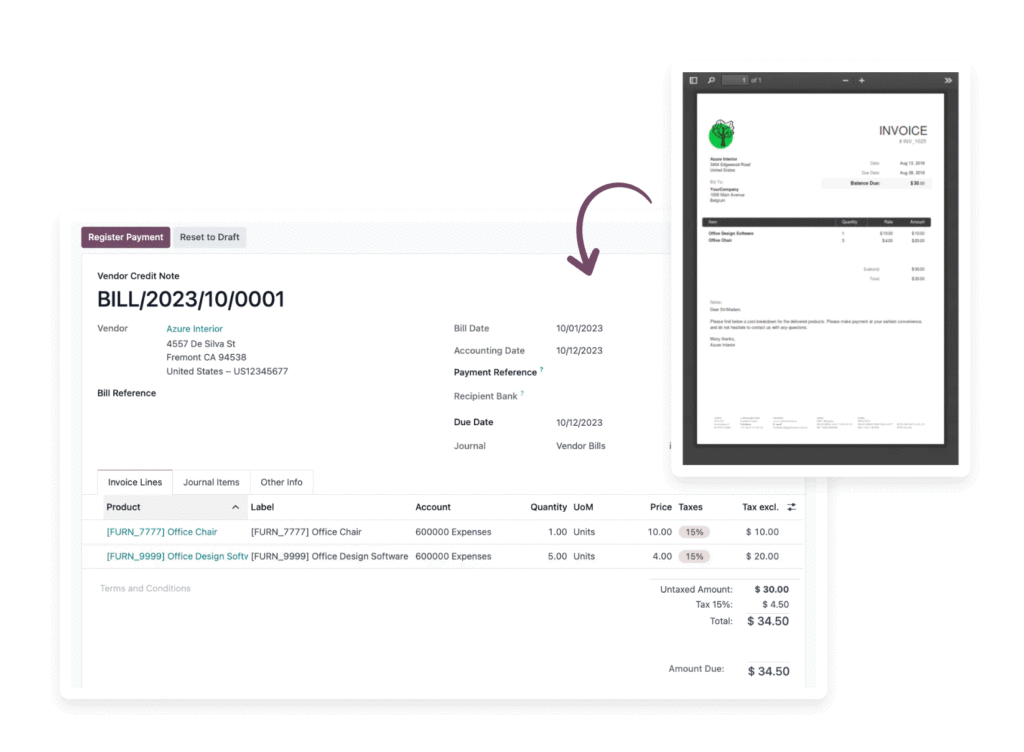
Odoo for Financial Services: Key Features and Strategies
Within the financial services sector, an upgrade to Odoo ERP can present the opportunity for a better connected, more capable organization.
That’s the pitch, anyway — but switching to Odoo (or any modern ERP) presents some major challenges. For a successful migration, you’ll need to maintain regulatory compliance, ensure data security, and deliver a seamless client experience. You might also need to integrate certain department-specific solutions (for example, legacy payroll software) into the new ERP.
In a sector where the stakes are always relatively high, the software itself is only part of the equation. Odoo’s true power isn’t in its out-of-the-box features, but in its configurability: Virtually every feature can be precisely tailored to your firm’s specific operational and compliance needs.
Today, we’ll explore Odoo’s key capabilities for financial services and outline the strategic thinking required for a successful implementation. If you’re ready to explore whether Odoo can work for your organization, send us a message to schedule a demo.
Core Operations: Beyond the General Ledger
At its heart, Odoo is designed to streamline and automate core tasks (including accounting tasks, which are often a priority for non-financial institutions).
But for a financial services firm, the goal isn’t just to make accounting easier. You want to gain real-time visibility and control over the entire business. To that end, Odoo supports:
- Integrated Accounting: Odoo’s accounting suite is capable of automating everything from client invoicing and supplier bill processing to payment reminders and expense tracking. Its AI-powered invoice capture boasts a 98% recognition rate per Odoo, minimizing (though not eliminating) manual data entry.
- Strategic Reporting: While Odoo provides standard reports (P&L, balance sheets, etc.), its analytic accounting features can be the true game-changer. With dynamic reports, you can track costs and revenue by any dimension you choose — for example, a specific service line, a department, or an individual wealth advisor.
- Multi-Entity Management: For firms with a global footprint, Odoo seamlessly manages operations across multiple companies and currencies from a single platform. It handles daily exchange rate updates automatically, ensuring that financial consolidation is both simple and accurate.
These features require substantial planning for appropriate implementation. That might sound obvious, but if you haven’t identified the exact features you need (or want), Odoo won’t solve that problem for you.
For example, the AI-powered invoice feature can be useful, but it’s not appropriate for all firms; the “average” 98% success rate may not apply if you handle unconventional invoices on a regular basis, and it may not be necessary if you’ve already got a process in place for that type of automation.
Likewise, the reporting features work best when Odoo is your primary system. If you’re still utilizing legacy systems, you’ll need to bring that data into Odoo before you can use it to gain actionable insights (which might mean a custom API development or a customized Odoo module).

Odoo for Security and Compliance
An ERP must actively support regulatory adherence; it shouldn’t complicate it. Odoo provides a robust framework, though once again, a strategic implementation is essential to make it effective.
- Layered Security: Odoo’s security model is built in layers. It includes Role-Based Access Control (RBAC) to ensure employees only see the data relevant to their jobs, Two-Factor Authentication (2FA) to prevent unauthorized access, and end-to-end encryption for all data. Odoo never stores credit card information on its own systems, transmitting it directly to PCI-compliant payment processors.
- Compliance Framework: Odoo is designed to support international standards like IFRS and GAAP, as well as data privacy regulations like GDPR. For the financial sector, specific apps are available to address crucial requirements like the EU’s Anti-Money Laundering (AML) sanctions screening.
A capable Odoo partner will recognize that compliance is a business process, not just a software feature. Your goal is to configure your system and workflows to ensure proper procedures are followed, tracked, and auditable.
Tailoring Odoo for Your Niche
The financial services industry isn’t a monolith. A retail bank has vastly different needs than a wealth management firm or an insurance agency. Odoo’s modularity allows it to be adapted to these specific verticals, but it requires a partner who understands that not every feature will be necessary out-of-the-box — and some existing workflows might not need to be changed.
For example:
- Lending and Loan Management: Odoo has dedicated modules that can manage the entire lending lifecycle, from application and approval to disbursement and repayment scheduling. It can automate journal entries for each installment and manage various complex loan types, providing a single source of truth for your lending portfolio.
- Wealth and Asset Management: While Odoo’s core asset module is for physical assets, its powerful accounting and reporting engine provides a strong foundation for the back-office needs of a wealth management firm (for instance, the advisory firm Vantage Wealth Management uses Odoo). Customization is often key here to build tailored client portfolio views and automate complex fee structures.
- Insurance Operations: Odoo can be configured to manage the full insurance value chain, from a CRM for tracking leads and managing policies to claims processing and financial reconciliation. That can eliminate the data silos that often slow down insurance operations, which translates to faster claims processing and better customer service (again, with the right implementation).
Building Your Odoo Implementation Strategy
Odoo’s a powerful tool, and as an Odoo implementation partner, we’re frequently advocating for Odoo over other ERP solutions. After all, we use Odoo ourselves.
But like any tool, Odoo’s ability to deliver value depends entirely on the plan behind it. At Blue Stingray, we take the time to conduct a thorough needs assessment before beginning any ERP implementation project. In some cases, we recommend against Odoo — in others, we might configure Odoo to work with legacy systems, or build custom Odoo apps that are better suited to the actual day-to-day needs of a certain financial business.
We take that step because that’s the only approach that makes sense: Odoo is much more powerful than a standard ERP, which makes planning that much more important. Pinpoint customizations ensure that it provides everything a business needs to function more effectively — without feature bloat, and without forcing each department to change the way they work.If you’re ready to explore how a well-planned Odoo implementation can support your firm’s security, compliance, and growth, contact us today to schedule a demo.




